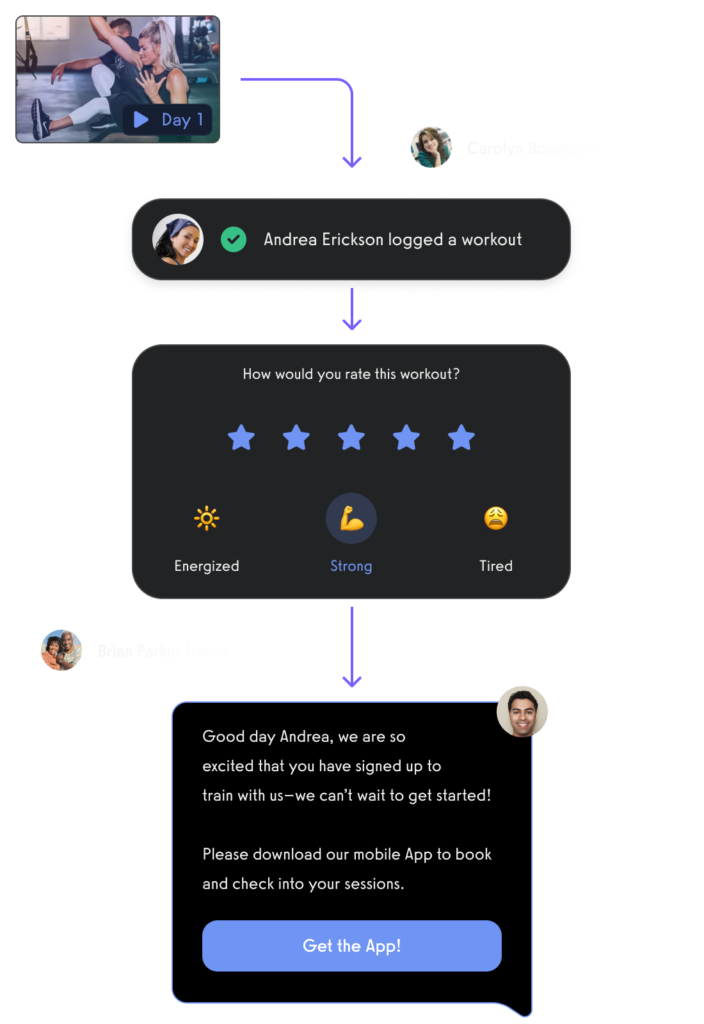Personal Trainer Payment Agreement Template (FREE)
Use this free personal trainer payment agreement template to ensure fair and transparent payment terms with your clients.

As part of a free personal trainer contract template, this personal trainer payment agreement template is here to ensure you have fair personal training payment terms with your clients.

And, of course, managing your fitness business online with the best gym management software and the best personal training software means that you can easily create personal training payment agreements to send to clients with email, SMS, and in-app messaging marketing cadences, you can create fitness session plans, waivers, forms, fitness assessments, lead forms, registration forms, offer online booking, workout plans, and much more.
Accept payments automatically with the best gym payment processing software that makes it easy to accept personal trainer payments online or in-person.

Use the Exercise.com workout plan creator to create your workout plans and fitness assessments.

Publish your custom branded fitness apps to iOS and Android so you can offer a premium experience to your community.

Run fitness challenges, create online workout groups, do distance training, and of course, deliver fitness assessments and workouts, all right within the Exercise.com platform (custom branded to your brand).

You can even trigger your online personal trainer payment agreements to send automatically to clients based on key triggers.


Personal Trainer Payment Agreement Template
Trainer Information:
Name: [Trainer’s Full Name]
Certification: [Certification Details]
Contact Info: [Phone Number, Email Address]
Client Information:
Name: [Client’s Full Name]
Address: [Client’s Address, City, State, ZIP]
Contact Info: [Phone Number, Email Address]
[Date]
Agreement Overview
This Personal Trainer Payment Agreement is entered into by and between Trainer’s Full Name and Client’s Full Name on the date stated above. This agreement outlines the payment terms and conditions associated with personal training services provided by the Trainer to the Client.
Services to be Provided
The Trainer will provide personal training services as follows:
- Type of Training: [e.g., Strength Training, Cardiovascular Fitness, Flexibility Training]
- Session Length: [e.g., 60 minutes]
- Frequency: [e.g., 3 times per week]
- Location: [Training location or facility]
- Start Date: [Start date of training]
- End Date: [End date of training, if applicable]
Payment Terms
- Session Rate: The Client agrees to pay the Trainer a rate of [Amount] per [hour/session].
- Package Option: [If applicable, detail any package rates, e.g., “10 sessions for $500, to be paid upfront.”]
- Payment Schedule: Payments shall be made [e.g., weekly, monthly, per session] by [payment method].
- Late Payment Policy: Late payments shall incur a fee of [Amount or Percentage] after a grace period of [Number of Days].
- Cancellation Policy: Cancellations must be made [Number of Hours] in advance. Late cancellations may be subject to a [Cancellation Fee Amount].
- Refunds: All payments are [non-refundable/refundable under specific conditions].
Additional Terms
- Renewal: This agreement is subject to renewal upon mutual agreement of both parties with adjusted terms if necessary.
- Termination: Either party may terminate this agreement with [Number of Days] notice. Any prepaid sessions will be refunded on a pro-rata basis.
- Liability: The Client acknowledges the risks associated with physical exercise and releases the Trainer from any liability for injury or health issues arising from the training program.
Acceptance
By signing this agreement, both parties acknowledge understanding and agreement to the terms and conditions stated above.
Trainer Signature: ______________________________
Date: __________________
Client Signature: ________________________________
Date: __________________
This Personal Trainer Payment Agreement Template provides a clear and comprehensive outline of the financial arrangements between a personal trainer and their client. It covers payment rates, schedules, cancellation policies, and other relevant terms to ensure a mutual understanding and smooth working relationship. This template can be adapted to fit individual trainer-client agreements, ensuring that both parties have clear expectations and responsibilities regarding payments for personal training services.
Ready to automate your personal training business and send online personal training payment agreements and forms electronically with online fitness assessments?

Understanding the Importance of a Personal Trainer Payment Agreement
Looking for a personal trainer payment agreement template? This article provides a comprehensive guide on creating a legally binding agreement that outlines payment terms, cancellation policies, and other important details.
In this article, we will delve deep into the world of personal trainer payment agreements, understanding their importance, key components, tips for creating an effective agreement, and much more. By the end of this comprehensive guide, you will be equipped with all the knowledge you need to protect yourself legally and simplify the payment process for your personal training business.
As a personal trainer, your expertise and guidance play a vital role in helping individuals achieve their fitness goals. However, it’s equally important to protect your own interests when it comes to payment. A personal trainer payment agreement serves as a legally binding document that outlines the agreed-upon terms and conditions between you and your clients. By having a clear and concise agreement in place, you can ensure that both parties are on the same page regarding payment expectations, schedule, and any potential additional fees or cancellation policies.
A written agreement serves as a safeguard against misunderstandings or disputes that may arise in the future. It helps establish a professional and transparent relationship with your clients and sets clear boundaries. Moreover, having a well-structured payment agreement demonstrates your professionalism and commitment to providing a high-quality service.
One important aspect to consider when creating a personal trainer payment agreement is the payment method. Clearly state in the agreement the accepted forms of payment, such as cash, check, or electronic transfer. Additionally, you may want to include any specific instructions or deadlines for payment submission to ensure a smooth and timely transaction process.
Another crucial element to include in the payment agreement is a clause regarding late or missed payments. Specify the consequences of late payments, such as late fees or suspension of services, to encourage clients to make timely payments. This clause will help protect your business and ensure that you are compensated for your services in a fair and timely manner.
Key Components of a Personal Trainer Payment Agreement Template
Now that we’ve established the importance of a personal trainer payment agreement, let’s dive into the key components that should be included in your template:
- Client and personal trainer information: This includes the full name, contact details, and any relevant identification numbers.
- Payment details: Specify the agreed-upon payment rate, frequency, and preferred method of payment.
- Session schedule: Outline the number of sessions per week or month, the duration of each session, and any specific days/times agreed upon.
- Additional fees: If there are extra charges for late cancellations, rescheduling, or any additional services, clearly define them to avoid confusion.
- Cancellation policy: State your policy regarding cancellations and rescheduling. Be sure to provide a notice period for both parties.
- Liability waiver and indemnification: Protect yourself by including a liability waiver that releases you from any responsibility in case of injuries or accidents during training. Additionally, an indemnification clause can safeguard you from any legal claims arising from client negligence.
- Termination clause: Outline the conditions under which either party can terminate the agreement and any consequences or refunds that may apply.
Tips for Creating an Effective Personal Trainer Payment Agreement
Creating an effective personal trainer payment agreement requires careful consideration and attention to detail. Here are some tips to help you draft a comprehensive and enforceable document:
- Seek legal advice: While it may be tempting to create a payment agreement yourself, consulting with a lawyer who specializes in contract law can provide peace of mind and ensure that your agreement is legally binding.
- Be specific: Clearly define all terms and conditions, including payment rates, scheduling details, and any potential additional fees. Ambiguity can lead to confusion and disputes.
- Use plain language: Avoid using complicated legal jargon that may confuse clients. Aim for simplicity and clarity so that both parties fully understand the agreement.
- Consider local regulations: Familiarize yourself with any local or regional laws that may affect your payment agreement. Staying compliant is essential for legal protection.
- Customize your template: While utilizing a standardized template is a great starting point, make sure to tailor it to suit your specific business needs and practices.
- Keep records: Maintain a copy of the signed agreement for your records. This will serve as evidence in case of any disputes.
Customizing Your Personal Trainer Payment Agreement Template to Suit Your Needs
Every personal training business is unique, and your payment agreement should reflect your specific requirements. When customizing your template, consider these factors:
- Business structure: Are you a sole proprietor or part of a larger organization? Your agreement may need to reflect the nature of your business.
- Services offered: Do you provide additional services such as nutritional guidance or customized workout plans? If so, include them in your agreement.
- Payment options: Besides standard cash or card payments, do you accept online transfers or installment plans? Specify your preferred payment methods.
- Location-specific regulations: Some regions may have specific requirements or laws concerning personal training agreements. Research the laws relevant to your location to ensure compliance.
Essential Clauses to Include in Your Personal Trainer Payment Agreement
When drafting your personal trainer payment agreement, certain essential clauses must be included to protect your interests. These include:
- Confidentiality clause: Ensure that any client information shared during training sessions remains confidential.
- Intellectual property rights: Clarify ownership of any training programs, exercise routines, or nutritional plans you provide.
- Force majeure clause: Account for unforeseen circumstances that may hinder or prevent the delivery of your services, such as natural disasters or pandemics.
- Dispute resolution clause: Specify a process for resolving any disagreements that may arise, such as mediation or arbitration.
- Governing law clause: Determine the governing law that will apply to your payment agreement.
Ensuring Fair and Transparent Payment Terms in Your Personal Trainer Agreement
Transparency is key when it comes to payment terms in your personal trainer agreement. By ensuring fairness, you build trust with your clients and establish a solid foundation for a long-lasting professional relationship. To achieve this:
- Clearly communicate your rates and any potential additional fees upfront.
- Provide a detailed breakdown of what your clients can expect from each session or package.
- Explain your cancellation and refund policies in a straightforward manner.
- Be willing to answer any questions or concerns your clients may have regarding payment terms.
Negotiating Payment Terms with Clients: Best Practices for Personal Trainers
While you may have a standard payment agreement template, there may be instances where clients request modifications or negotiations. Here are some best practices for handling these situations:
- Be open to discussion: Listen to your clients’ concerns or requests and be willing to negotiate within reason.
- Clearly communicate any changes: If you agree to modify the payment terms, ensure that both parties are aware of and understand the amended agreement.
- Put it in writing: Formalize any agreed-upon changes by updating the payment agreement and obtaining signatures from all parties involved.
- Maintain professionalism: Even in negotiations, remember to conduct yourself professionally and ensure that the agreed-upon terms are fair for both parties.
Common Mistakes to Avoid When Drafting a Personal Trainer Payment Agreement
Creating a personal trainer payment agreement is not without its challenges. Here are some common mistakes to avoid:
- Being vague or ambiguous: Clearly define all terms and conditions to prevent misunderstandings.
- Omitting important details: Leave no room for assumptions by including all necessary information, such as payment rates, session duration, and cancellation policies.
- Using complex language: Keep your agreement simple, concise, and easily understandable for both you and your clients.
- Not seeking legal advice: Consulting with a lawyer ensures that your agreement complies with applicable laws and provides adequate protection.
- Forgetting to update the agreement: As your business evolves, periodically review and update your agreement to reflect any changes in your pricing or services.
How to Protect Yourself Legally with a Well-Structured Personal Trainer Payment Agreement
A well-structured personal trainer payment agreement can provide you with legal protection and peace of mind. To enhance your legal safeguards:
- Consult with a lawyer to ensure your agreement is comprehensive and enforceable.
- Include a liability waiver and indemnification clause to protect against any legal claims.
- Clearly define your responsibilities and limitations as a personal trainer to minimize potential liability.
- Ensure the agreement is signed by both you and your client to demonstrate mutual consent and understanding.
- Store copies of signed agreements securely for future reference if needed.
Simplifying the Payment Process with a Clear and Concise Personal Trainer Agreement Template
An organized and straightforward personal trainer agreement template can simplify the payment process for both you and your clients. By utilizing a well-structured template, you can:
- Standardize your payment terms and conditions, ensuring consistency across your client base.
- Save time and effort by not having to create a new agreement for each client.
- Reduce the risk of errors or omissions in your agreement as the template will cover all necessary components.
Exploring Different Types of Compensation Models for Personal Trainers
When it comes to compensating personal trainers, various models exist. Understanding these models can help you choose the one that aligns best with your business goals and client needs. Some common compensation models include:
- Hourly rate: Charging a set amount per hour of training.
- Session-based fee: Charging a fixed price per session or package.
- Monthly retainer: Receiving a pre-determined monthly fee for a set number of sessions.
- Percentage-based model: Earning a percentage of revenue generated through client referrals or class participation.
- Hybrid models: Combining different compensation models to create a unique payment structure.
Benefits of Using a Standardized Personal Trainer Payment Agreement Template
Utilizing a standardized personal trainer payment agreement template offers a range of benefits for both you and your clients:
- Efficiency and consistency: Saving time by using a pre-designed template ensures that all key components are included and allows for a smooth onboarding process.
- Professionalism: A professional and well-structured agreement instills trust and confidence in your clients.
- Legal protection: A carefully crafted template with appropriate clauses can safeguard your interests if disputes or issues arise.
- Flexibility: A template can easily be customized to suit your specific business practices and objectives.
Addressing Potential Disputes and Resolving Issues in Your Personal Trainer Payment Agreement
Even with a clear and comprehensive payment agreement in place, issues may still arise. To address potential disputes:
- Reach out to your client: Communication is key – discuss the issue openly with your client to understand their concerns or grievances.
- Refer to the agreement: If the dispute relates to payment terms, refer back to the payment agreement to clarify any misunderstandings.
- Consider mediation: Engaging a neutral third party can help facilitate a resolution and maintain a positive client-trainer relationship.
- Seek legal advice if necessary: If disputes cannot be resolved amicably, contact your lawyer to explore further legal action.
Understanding the Legalities and Regulations Surrounding Personal Training Payments
When it comes to personal training payments, it’s essential to be aware of relevant legalities and regulations. Some legal considerations include:
- Tax obligations: Understand your responsibilities for reporting and paying taxes on your personal training income.
- Licensing and certification: Ensure you possess the necessary licenses and certifications required by your jurisdiction.
- Data protection: Follow applicable data protection laws to safeguard client information.
- Compliance with consumer protection laws: Familiarize yourself with any laws specific to your region that protect consumers’ rights.
- Insurance coverage: Consider obtaining liability insurance to protect against potential claims arising from your personal training services.
Now that you have a comprehensive understanding of personal trainer payment agreements, it’s time to create or update your own template. Remember, a well-structured and clear agreement is not only for legal protection but also for building trust and professionalism in your personal training business. Take the time to design a template that suits your specific needs, and always seek legal advice if necessary. With a solid payment agreement in place, you can focus on what you do best – helping your clients achieve their fitness goals!
How do personal trainers take payment?
Personal trainers often take payment through various methods, including cash, checks, credit/debit cards, or online payment systems. Some use gym management software like Exercise.com, which facilitates online billing and recurring payments for sessions or packages.
How do I write a personal trainer contract?
To write a personal trainer contract, clearly outline the terms and conditions of your services. Include details such as session length, package prices, payment terms, cancellation policies, liability waivers, and any other specific agreements between you and the client.
Read More: Personal Training Contract Template
What should a personal trainer contract include?
A personal trainer contract should include details of services offered, pricing and payment terms, cancellation and refund policies, client obligations, a liability waiver, and any special terms or conditions relevant to the training arrangement.
Read More: Personal Training Contract Template
How do you charge clients for personal training?
Charging clients for personal training can be done per session, through packages (e.g., 10 sessions at a discounted rate), or on a monthly basis for ongoing training. Choose a model that aligns with your business strategy and client preferences.
How much do most personal trainers charge per month?
Monthly charges by personal trainers vary widely based on location, trainer experience, and the type and frequency of sessions. Rates can range from a few hundred to over a thousand dollars per month.
What do most personal trainers charge per hour?
Personal trainers typically charge between $30 to $100 per hour, depending on their location, experience, and the client’s training needs. Rates in urban areas or for specialized training can be higher.
Should personal trainers have an LLC?
Having an LLC can be beneficial for personal trainers as it provides legal separation between personal and business liabilities and can offer tax benefits. However, the decision should be based on individual business needs and consultation with a legal expert.
How profitable is being a personal trainer?
Profitability as a personal trainer depends on factors like the number of clients, session rates, operating costs, and additional income streams (e.g., online coaching, merchandise sales). It can be a lucrative career, especially for those with a strong client base and diverse income sources.
Can personal trainers write off gym memberships?
Personal trainers can often write off gym memberships as a business expense if the membership is necessary for their work, such as training clients or maintaining their fitness level. However, it’s advisable to consult with a tax professional.
How many clients should a personal trainer have per week?
The ideal number of clients per week varies based on session length, the trainer’s capacity, and the business model. A full-time personal trainer may handle 20-30 sessions per week, balancing quality of service with workload.
How many clients is good for a personal trainer?
A good number of clients for a personal trainer depends on their schedule, training format, and business goals. Typically, managing 15-25 clients per week is considered a robust client base while maintaining quality service.
How do you write a fitness contract?
Writing a fitness contract involves outlining the terms and conditions of fitness services. Include details about the services, payment terms, cancellation policy, client commitments, and liability waivers. Ensure clarity and legality in the contract.
Are you supposed to tip personal trainers?
Tipping personal trainers is not typically expected, as they are usually paid per session or package. However, clients may choose to offer tips as a gesture of appreciation for exceptional service.
How can I use Exercise.com to accept payments for personal training?
Exercise.com provides a platform for personal trainers to accept payments for services through its software. It supports various payment methods, including credit cards and online transactions, making it convenient to manage billing, package sales, and recurring payments directly through the platform.










